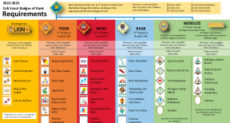 Time for answers to a couple more of your questions.
Time for answers to a couple more of your questions.
Why do we recharter in December?
Fall is the time that we recruit for Cub Scouting. Many troops and crews recruit new members in the fall as well. So with all these applications coming in, and with our packs renewing their members for the coming Scouting year, I have been asked why we don’t just renew our charters in September and get it over with, rather than having to go through the roster audit process a few months later.
As a practical matter, that may seem to make sense. We would collect new applications and fees from renewing members, turn them in and be finished. However, the charter renewal process is more than just tallying your membership list and writing a check.
The reason we renew our charters annually is because it gives the local council and the chartered organizations an opportunity to re-connect and to confirm the chartered organization’s commitment to support Scouting as part of its community outreach and service to youth. The chartered organization reviews its adult leadership roster and training and completes the Journey to Excellence assessment as a checkpoint on its performance over the last twelve months.
One of the steps critical in this process is the visit between the unit-serving professional and the head of the chartered organization. Sometimes the chartered organization representative and unit commissioner also join in. This is possibly the only time the CO’s executive officer gets updated on what’s new in Scouting and how the unit it charters is serving the young people of its community. These meetings take place over the course of several weeks two to three months prior to rechartering. If rechartering was done in September, they would be happening over the summer when many people are on vacation and our council staff is busy making preparations for the fall recruiting effort.
Another very practical reason we wait a couple months to do the official rechartering is that in the fall, many units’ membership lists are in a state of flux. What would happen if the recharter date were, say, September 30? Your paperwork would have to be completed by the 15th, meaning you’d have to finalize your roster by around September 1. I doubt there are any packs or troops that know exactly everyone who is returning and who isn’t by that date. Do you renew them or not? And what about those who join in the weeks following your official recruiting effort?
By taking a snapshot of your roster a month or two into your program year, you’re getting a more accurate picture of your membership, both for you and for Scouting.
Scouts with severe disabilities
I had a question from a reader asking how the parent of a Scout with disabilities can extend his eligibility for youth membership in a troop beyond his 18th birthday.
The answer is found in the 2013 Guide to Advancement in section 10, which covers advancement for members with special needs. Paragraph 10.1.0.0 describes the qualifications in such cases, 10.1.0.1 lists some of the possible criteria (being mindful that a combination of disabilities otherwise not regarded as severe could result in a more advanced case), and 10.1.0.2 outlines the procedure that councils must follow.
Basically, the Guide states that a youth member who has a permanent disability that results in his comprehension or ability level below his actual age that otherwise prevents him from learning or advancing despite the accommodations for alternate requirements can petition the council to allow him to be registered past the age of eligibility (11 for Cub Scouts, 18 for Boy Scouts and 21 for Venturing and the non-traditional programs). This has to be supported with a letter from the parent, the unit leader and his doctor or psychologist.
In order to be considered, the disability has to be severe enough to preclude his ability to meet even the alternate requirements provided. It cautions that an exemption probably won’t apply if rank requirements can be met using accommodations in official literature or outlined in the Guide.
What’s the next step? The parent of the Scout should discuss the matter in confidence with a professional Scouter serving their district. Depending on the local council’s procedures, they may be referred to the Scout Executive, another council professional or the council advancement committee. Understand, too, that it’s never one person’s decision; these matters are taken up by a committee and the pros and cons are discussed before reaching a conclusion.
My experience is that young people who genuinely require special accommodations in order to be able to fulfill the promise of Scouting have access to them.
Any parent of a special-needs Scout of any age would be well served to read Section 10 of the Guide to Advancement to get a better understanding of how the BSA helps those with disabilities enjoy the benefits of our movement.
Do you have a question? I’d be happy to help you find an answer to questions or situations that have come up that you need some illumination for. Please visit the Contact page and send me an e-mail and I’ll get to work for you.
This post first appeared on Bobwhite Blather.



